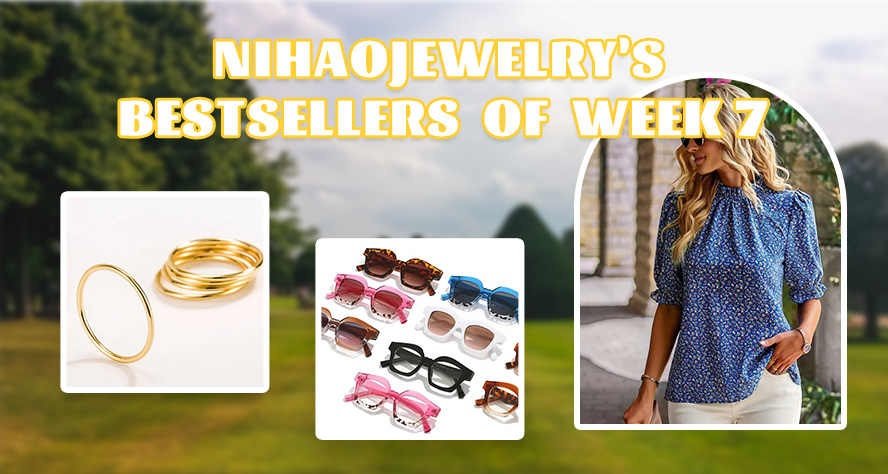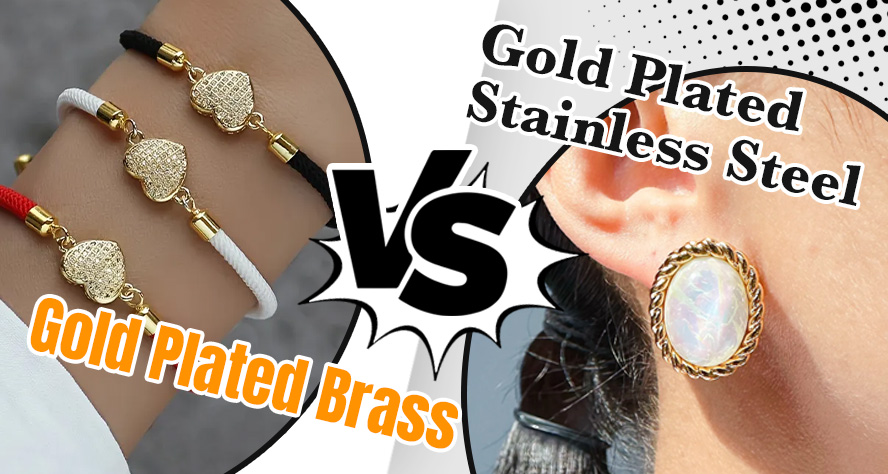When it comes to jewelry, some of the more popular materials in the last couple of years are titanium vs stainless steel.
They both have unique properties that make them excellent choices for different types of jewelry.
But titanium vs stainless steel jewelry, which material is better?
In this article, we will discuss the main differences between titanium steel and stainless steel jewelry.
- What is Titanium Steel
- What is stainless steel
- Titanium vs Stainless Steel,8 reasons to tell you which one is better for your business?
- In Conclusion
What is Titanium Steel
The name titanium steel is not a standard academic name, but a commercial one.
Titanium steel is stainless steel and does not contain titanium, the material used is not titanium, but 316L stainless steel.
It is the so-called ‘titanium steel’ for commercial interests.
Some even called titanium alloy jewelry, but in fact, it is stainless steel without titanium.
316L is a stainless steel number, China’s unified numerical code for S31603 is based on 316 stainless steel to continue to reduce the carbon content obtained.
Among the common stainless steels, 316L stainless steel called ”titanium steel” is suitable for jewelry.
The unique metallic luster and material properties of titanium steel become the focus of fashion jewelry.
Advantages of titanium steel
Titanium steel jewelry can be used for a long time without deformation or discoloration.
In addition, it is non-toxic and harmless to the human body and can be soaked in water for a long time.
Artificial sweat tests are non-corrosive, non-discoloring, non-fading, and non-allergenic.
These features make them ideal for heirlooms, wedding bands, earrings, and necklaces. Find more Titanium Steel Earrings.
Due to the quality of titanium steel and it does not tarnish, many vendors carry the name titanium steel, but the vast majority of them are stainless steel alloy jewelry.
Disadvantages of Titanium Steel
- Titanium steel is hard and less tough. It is more suitable for processing simple shapes of jewelry.
- Due to the hard texture of titanium steel, contact with sharp objects can scratch and damage the smoothness of its surface.
- Titanium steel is more expensive than stainless steel.
What is stainless steel
Stainless steel, according to the composition of the metal, is divided into 304,316,316L, etc. We are most commonly 304 stainless steel jewelry.
The main reason is that it is moderately priced and meets the characteristics of a variety of shapes.
Stainless steel in Europe and the United States market, the use of higher popularity, design style is also rich.
Characteristics of stainless steel
The advantages of stainless steel are that it is durable and colorfast, can be worn for a long time, and is more environmentally friendly.
The emergence of stainless steel jewelry has significantly improved the durability of the color, compared with the previous copper and iron alloy jewelry, stainless steel can retain its color for a longer period.
Gold-plated stainless steel jewelry is not easy to cause skin allergies, especially for those who are sensitive to nickel, this feature is particularly friendly.
In terms of style and design, stainless steel shows a wider acceptance, with a greater diversity of sizes, colors, and styles.
In addition, stainless steel is resistant to rust and scratches. This makes it an excellent choice for outdoor activities.
It is also made of a chrome layer that is resistant to oxidation and prevents physical damage to jewelry.
Click here to learn more about stainless steel.
Common Craftsmanship of Stainless Steel Jewelry
In recent years, stainless steel jewelry is constantly sought after by the public.
Its best feature is that it is wear-resistant and corrosion-resistant, very durable.
Stainless steel jewelry making is a complex process. As an experienced jewelry supplier, Nihaojewelry provides us with high-quality and rich stainless steel jewelry.
Their common processes include etching, casting, hydraulic, and cutting.
- Cutting
The process of cutting stainless steel involves heating the material to a high temperature using a high-energy laser beam.
Gas jets or mechanical movement are then used to vaporize or melt the material in the area to be cut.
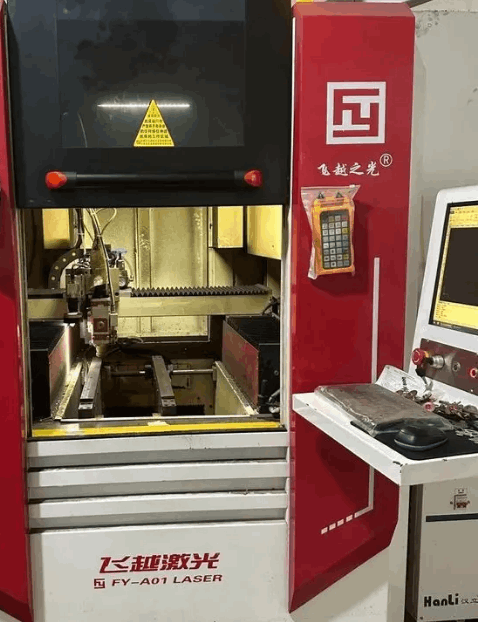
The operator first needs to design the pattern of the product on the computer software and then import it into the CNC machine.
After selecting the steel plate material, the machine can cut according to the set path.
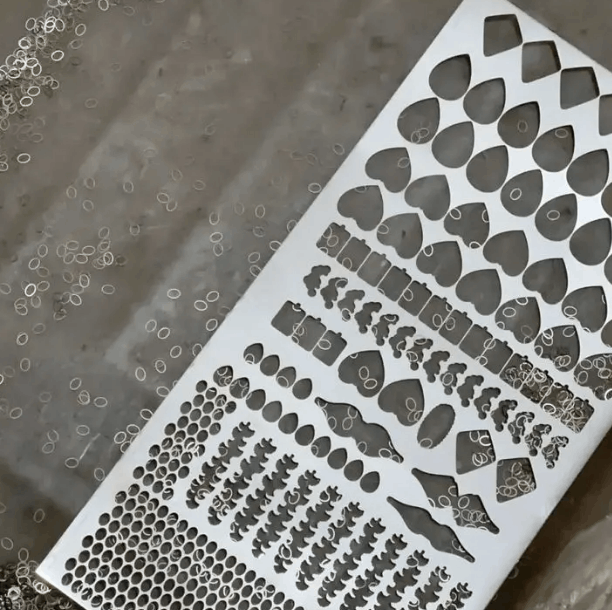
- Etching
If you think that relying on laser cutting alone is a bit monotonous, you can also add a touch of design with some metal processes, such as the etching process.
The etching process involves placing stainless steel in an acidic solution, which etches textures and patterns into its surface.
This method can yield a variety of different effects, from grainy textures to subtle patterns.

The etching process can be set up in a variety of patterns, such as botanical flowers, geometric lines, and text logos.


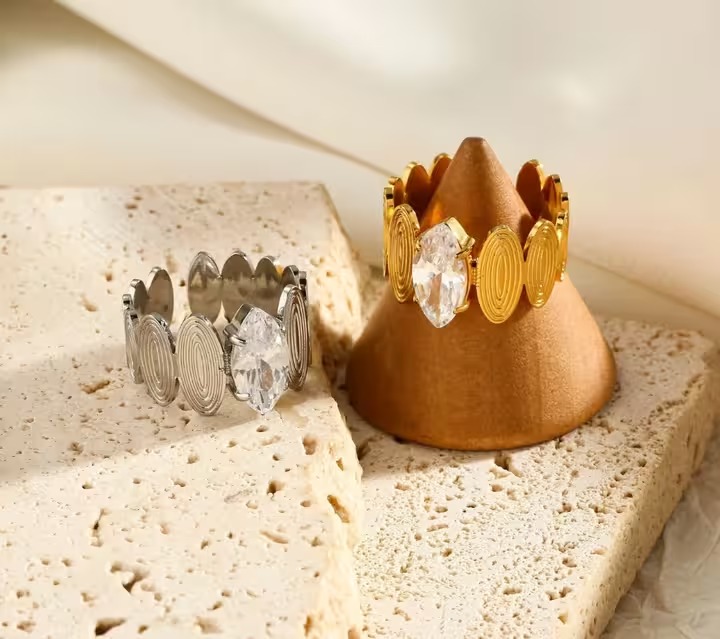
Like this ring, the line pattern on both sides, which is also etched out, is combined with a cast diamond-set fitting in the center.
- Casting
Another important process is casting. This involves melting stainless steel at a high temperature of 2,000°C.
It is then poured into a pre-made wax-gel model and cooled to obtain monolithic molded jewelry.
Very high temperature and cooling control is required, otherwise, cracks and breakage can occur. The molds are varied and complex.
Although the process is demanding, larger and more delicate jewelry can be produced.

Etching can obtain fine patterns but is not suitable for large pieces.
Casting allows for large overall pieces, but the pattern detail is weak.
These two techniques can also be combined, the first corrosion of the pattern, and then casting assembly.
Of course, you can also cast the whole piece, and then corrosion modification. For example, the bracelet’s center can be cast, and the sides are decorated with corrosion patterns.
- Hydraulic Press
Making stainless steel jewelry will also use the hydraulic pressure process.
In stainless steel jewelry making, the hydraulic press can adjust different molds to achieve the processing of stainless steel materials.

The hydraulic pressing process can add three-dimensional curves to otherwise flat leaf shapes, as well as press small accessories.
Unlike casting, oil pressing allows for finer results.

The surface of the jewelry after Hydraulic pressing is rough and needs to be polished.
The Hydraulic pressing process extends the shaping possibilities of stainless steel, and the polishing process gives it a more refined appearance.
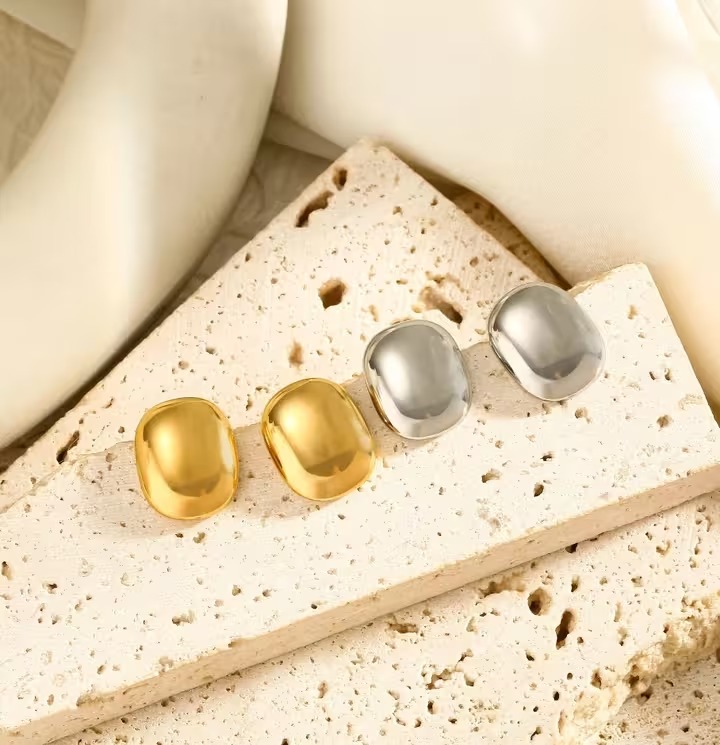
However, stainless steel is a different material than other metals and requires the use of vacuum plating to achieve the desired color retention.
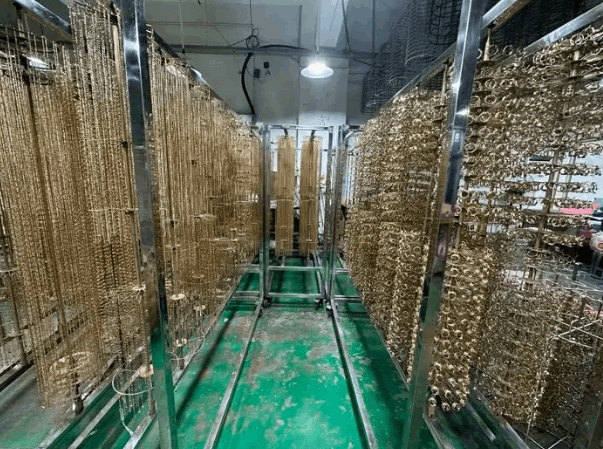
Get more details about stainless steel jewelry.
Titanium vs Stainless steel, 8 reasons to tell you which one is better for your business?
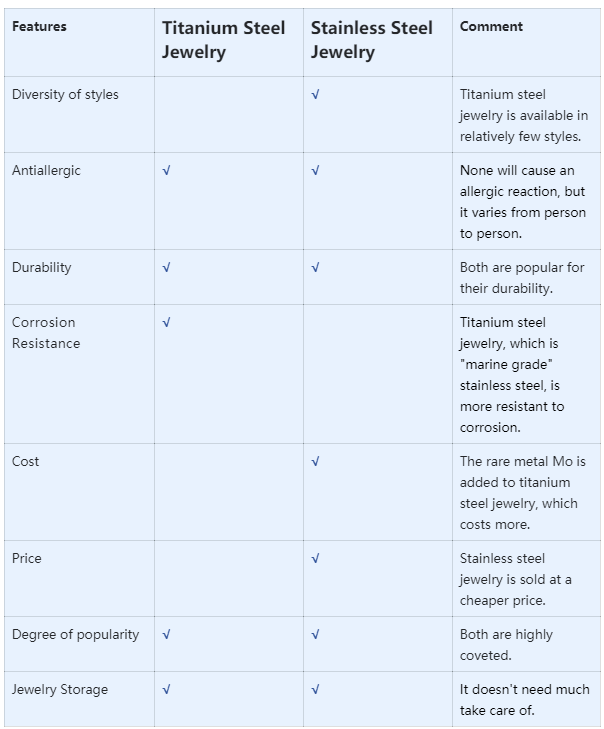
As stated earlier, titanium steel is stainless steel.
The difference between stainless steel jewelry and titanium steel jewelry is the difference in the composition of the metal itself.
For most people, both metals are safe to wear as body jewelry because both are durable.
For Titanium vs Stainless Steel, We’ve summarized the following 8 differences between these two types of jewelry to help you make your choice:
Diversity of styles
Titanium steel is harder and less tough, making it more suitable for working with simple shapes of jewelry.
For minimalists, titanium steel jewelry offers a sleek, modern look. If your customers prefer high-quality minimalist jewelry, then you can choose titanium steel jewelry.
However, stainless steel is less expensive to process and can accommodate a wide variety of shapes.
If you want to offer a wider variety of styles to your users, then stainless steel jewelry is the best choice.
Antiallergic
For people with sensitive skin or allergies to metals, choosing the right jewelry material is critical to avoid irritation or allergic reactions.
Stainless steel jewelry is hypoallergenic. Generally, jewelry with less than 10% reactive metals such as nickel and copper is considered hypoallergenic.
Theoretically, stainless steel and titanium steel jewelry (316L stainless steel jewelry) are unlikely to cause allergic reactions in people with sensitive skin.
However, this also depends on the individual’s constitution and varies from person to person.
Stainless steel jewelry does contain small amounts of nickel. For people with nickel allergies or hypersensitivity, stainless steel jewelry may cause skin irritation, redness, and even more severe allergic reactions.
You should always warn users of this concern when selling.
Durability
Stainless steels are durable materials, but they differ in hardness.
Titanium steel is known for its outstanding strength and durability.
Due to the hardness of titanium metal, contact with sharp objects can scratch it and ruin the smoothness of its surface. Deep grooves may appear if the metal surface is in constant contact with a rough surface.
Stainless steel is also durable, but not as strong as titanium steel.
Stainless steel jewelry can scratch and lose its shine over time, but it’s still an excellent choice for everyday wear.
Do your users stay indoors more, or do they prefer the outdoors? Titanium steel jewelry may not be the best choice for the outdoors, while stainless steel is suitable for both uses.
Corrosion Resistance
Corrosion resistance is a key factor in jewelry as it determines the longevity and appearance of the jewelry.
Stainless steel jewelry is known for its corrosion resistance, but titanium steel jewelry is considered superior in this regard.
Titanium steel jewelry, or 316L stainless steel jewelry, is “marine grade” stainless steel and can be worn in environments with high chloride levels (such as salt water) or harsh chemicals.
It will not lose its luster, rust, or degrade even when exposed to water, sweat, or everyday chemicals. This is thanks to its natural resistance to corrosion.
While durable and corrosion-resistant, stainless steel tends to corrode over time, especially when exposed to moisture or acids.
When selling stainless steel jewelry, be sure to remind your customers to take proper care of it and avoid exposure to any harmful chemicals.
Cost
Cost is often a key factor when choosing jewelry.
Generally speaking, stainless steel jewelry is cheaper than titanium jewelry.
This is because stainless steel is more widely available and easier to manufacture, making it a more cost-effective option.
Most importantly, molybdenum (Mo) is a rare metal that is only added to 316L stainless steel, so titanium steel jewelry costs a bit more.
In addition to its rarity, titanium steel is also expensive to produce.
The refining process for titanium steel jewelry involves multiple steps, including extraction, purification, and reduction.
Each step requires energy-consuming processes and specialized equipment, which adds to the overall cost of production.
Combined, these two points make the cost factor for titanium steel jewelry several times higher than stainless steel.
If you’re on a budget and tend to favor sophisticated designs with a low-cost investment, you may want to look into stainless steel jewelry.
But for business owners who are focused on longevity and high-end performance, titanium steel jewelry is a worthwhile investment.
Price
Stainless steel jewelry is an affordable and versatile style staple. Not only is it inexpensive, but it comes in a variety of styles.
Stainless steel can be set with a variety of gemstones, pearls, zirconia, diamonds, and more. Therefore its wholesale price ranges from US$0.1-US$23.
As mentioned above, titanium steel is rare and expensive to make, in addition, it is a highly sought-after metal.
With a typical wholesale price of US$1-US$56 for titanium steel jewelry, it can bring higher profits to your store.
While stainless steel jewelry sells for cheap and it may be tempting for users to find cheaper titanium steel jewelry alternatives, the unique properties of titanium steel make it a hot seller.
It is important to note that some may refer to stainless steel as titanium steel jewelry because of commercial interests, and these are the usual tricks of many merchants.
Therefore, think twice when you come across titanium steel jewelry at a very cheap price when you are stocking up.
Degree of popularity
In the Euramerican Market, the use of stainless steel is more popular, and the design style is also more abundant.
In addition to electroplating and diamonds, can also be baked paint, transfer printing, and other processes for surface treatment.
The stainless steel jewelry consumer population covers all age groups.
Stainless steel styles for children include everything from stud earrings to book bag clasps.
While women are passionate about fashionable stainless steel jewelry, men can also find a wide selection of cast stainless steel jewelry.
In the early days titanium steel was the material of choice for watches and expensive fountain pens of some famous brands and was very popular in Europe and America.
Gradually titanium steel has been used in jewelry design and continues to be sought after by both merchants and users.
Although the market for stainless steel and titanium jewelry has grown significantly, due to its high acceptance, consumers have relatively high demands for style.
This has led to the continuous development and innovation of stainless steel jewelry to meet the needs of different customers.
Jewelry Storage
Titanium vs Stainless steel jewelry is popular for its durability, so it doesn’t require much maintenance or management.
But it’s important to store your jewelry inventory properly for your business.
Proper storage will prevent it from losing its luster or getting damaged.
- Ensure that all jewelry is clean and dry before storing.
- Sort jewelry by material to prevent jewelry from scratching or tangling with each other.
- Avoid storing jewelry near vents, windows in direct sunlight, or heat sources such as radiators.
- Keep the humidity in the storage area at a moderate level.
- Regularly inspect stored jewelry for signs of damage or loss of luster. For stainless steel jewelry in particular, regular cleaning and occasional polishing will help maintain luster and prevent the surface from dulling.
More jewelry care tips can be found in this article: How to Take Care of Your Jewelry: 5 Tips to Make It Bling
In Conclusion
In short, titanium steel is 316L stainless steel, made into titanium steel jewelry for appeal.
Titanium steel is stronger, more durable, and more resistant to corrosion than stainless steel jewelry, making it an excellent choice for those seeking high performance.
On the other hand, stainless steel is durable, versatile, and affordable, making it an excellent choice for everyday wear.
Ultimately, the choice between titanium vs stainless steel jewelry depends on the needs, style choices, and budget of an individual’s business.
What other jewelry materials would you like to know more about, feel free to leave them in the comments below.




